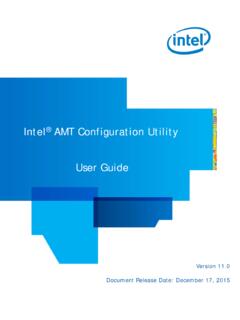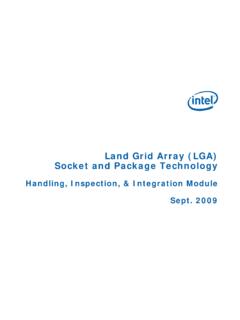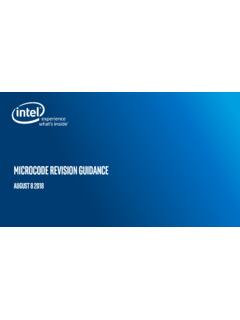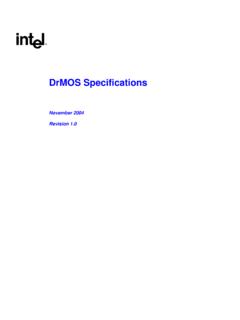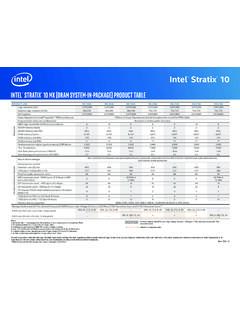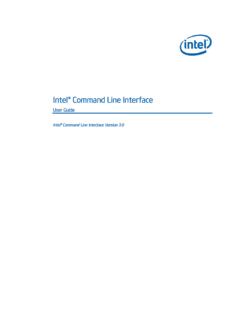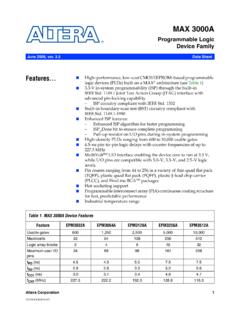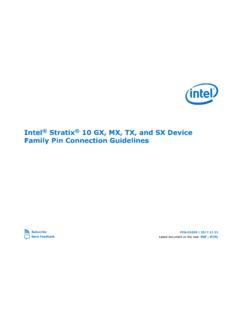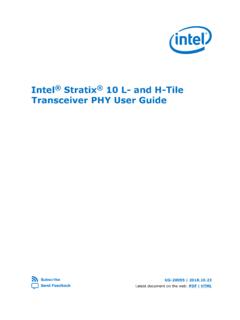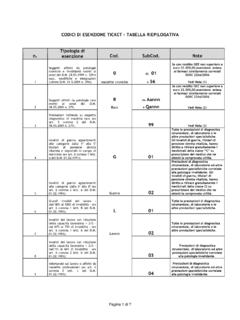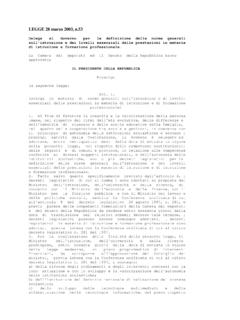Transcription of Configuring RAID for Optimal Perfromance 1.1
1 Configuring RAID for Optimal Performance Intel RAID Controller SRCSASJV. Intel RAID Controller SRCSASRB. Intel RAID Controller SRCSASBB8I. Intel RAID Controller SRCSASLS4I. Intel RAID Controller SRCSATAWB. Intel RAID Controller SRCSAS18E. Intel RAID Controller SRCSAS144E. Intel Server System SR2500 ALLX (Intel Integrated RAID). Intel Server System SR1550 ALSAS (Intel Integrated RAID). Intel Server Board S5000 PSLROMB (Intel Integrated RAID). Intel Server System S7000FC4UR (Intel Integrated RAID). Revision September, 2008. Enterprise Platforms and Services Division - Marketing Overview Configuring RAID for Optimal Performance Revision History Date Revision Modifications Number April, 2008 Initial revision September, 2008 Minor corrections Disclaimers Information in this document is provided in connection with Intel products. No license, express or implied, by estoppel or otherwise, to any intellectual property rights is granted by this document.
2 Except as provided in Intel's Terms and Conditions of Sale for such products, Intel assumes no liability whatsoever, and Intel disclaims any express or implied warranty, relating to sale and/or use of Intel products including liability or warranties relating to fitness for a particular purpose, merchantability, or infringement of any patent, copyright or other intellectual property right. Intel products are not intended for use in medical, life saving, or life sustaining applications. Intel may make changes to specifications and product descriptions at any time, without notice. Designers must not rely on the absence or characteristics of any features or instructions marked "reserved" or "undefined." Intel reserves these for future definition and shall have no responsibility whatsoever for conflicts or incompatibilities arising from future changes to them. Intel RAID Controllers may contain design defects or errors known as errata which may cause the product to deviate from published specifications.
3 Current characterized errata are available on request. Intel, Pentium, Itanium, and Xeon are trademarks or registered trademarks of Intel Corporation. *Other brands and names may be claimed as the property of others. Copyright Intel Corporation 2008. All rights reserved. 1. Configuring RAID for Optimal Performance Overview Table of Contents 1. Overview .. 3. 2. Performance Measurement 3. Copying large files .. 3. Tools without 3. IOmeter* .. 4. Measuring Performance under 4. 3. Optimal RAID Settings .. 5. 4. Impact of RAID Settings on Performance .. 6. Write 6. Write Back Mode .. 6. Write Thru Mode .. 6. Disk Cache 6. Read Ahead Policy .. 7. No Read Ahead (Normal) .. 7. Always Read Ahead .. 7. Adaptive Read 7. I/O Policy .. 7. Direct 7. Cached 7. Strip Size .. 7. 5. Other Performance Factors .. 8. Backup Battery Status .. 8. Virtual Drive Initialization .. 8. Patrol 8. Consistency Check .. 9. Data Location on Physical Drives.
4 9. PCI Express* Slot .. 9. 9. Overheating .. 10. 2. Overview Configuring RAID for Optimal Performance 1. Overview The target audience for this guide includes users, technical support personnel, and pre-sales personnel who work with Intel Server RAID products. It is assumed that the reader has a basic understanding of hard-drive operation, RAID operation, and RAID levels. This guide provides information to help achieve Optimal performance of a RAID array depending on the RAID level and performance measurement tool used. It does not include techniques for fine tuning RAID performance for a specific application. This guide covers Intel RAID Controllers and Intel Integrated RAID only. This guide does not cover Intel Embedded Server RAID Technology II. 2. Performance Measurement Tools When measuring RAID performance it is important to understand how the measurement tool works, the capabilities of the tool, and its limitations.
5 It is better to avoid using a tool with unknown or unclear data access patterns, which can make the results difficult to interpret. Copying large files Copying files with the Microsoft Windows* and Linux* standard OS utilities generates primarily sequential stream of data with 64 KB blocks and no queuing. Read Ahead (Always or Adaptive). and Write Back modes must be used to achieve good performance with this type of operations. Tools without queuing There are many tools available for measuring storage performance, but many of them do not have queuing capabilities and they can measure sequential throughput only. Without queuing, Read Ahead and Write Back caching modes must be used to achieve good throughput. Tools without queuing should not be used for measuring the maximum throughput capabilities of a RAID controller because the RAID cache causes a throughput bottleneck. This is especially important for read operations.
6 Some tools allow the access block size to be changed. If a large block size can be selected, this can partially mitigate the lack of queuing. For example, sequential throughput with 2 MB block size and no queuing may be similar to performance with 64 KB block size and a queue depth of 32 IOs. 3. Configuring RAID for Optimal Performance Performance Measurement Tools IOmeter*. IOmeter* ( ) is a sophisticated tool that can measure RAID performance, including sequential, random and mixed workloads, adjustable block sizes, and queuing. This tool requires certain level of proficiency to use it. Unfortunately, queuing does not work under Linux with the current IOmeter version One of the common mistakes made with IOmeter is setting the access type to mixed (random +. sequential). This selection will have big impact on performance measured in MB/s. For achieving maximum MB/s numbers, 100% sequential (0% random) access pattern must be used with a large enough block size (between 64KB and1MB).
7 Also the number of Outstanding I/Os (queue depth) typically should be in the 8-128 range. The following formula provides guidance for selecting Optimal outstanding I/Os and block size values: Outstanding_IOs x Block_Size = 2 x Strip_Size x Number_of_HDDs_in_Stripe The number of HDDs in stripe does not include parity HDDs. For example, RAID5 array with 9 HDDs will have 8 HDDs in the stripe. Measuring Performance under Linux The Linux* OS has a substantially different I/O queuing model (asynchronous I/O) than the Microsoft Windows* OS. We are not aware of any performance measurement tools that support I/O queuing for read operations under Linux. When measuring sequential read throughput under Linux, it is important to enable Read Ahead mode (either Adaptive or Always). 4. Optimal RAID Settings Configuring RAID for Optimal Performance 3. Optimal RAID Settings The following table provides a simplified quick reference for RAID settings for achieving Optimal performance depending on the type of application or test.
8 Please refer to the following sections for more details on the meaning and impact of each setting. Maximum Sequential Throughput Recommended Under Linux* or Microsoft settings for most real- Windows* without I/O world applications queuing IOmeter* under with sequential +. (Including copying files and Microsoft Windows* random storage using simple tools like access HDSpeed*). Strip Size 512K 512K 256K. Read Cache Direct I/O Direct I/O Direct I/O. Policy Read Ahead Adaptive Adaptive Read Ahead No Read Ahead Policy Read Ahead Write Cache RAID 0/10: Write Thru Write Back Write Back Policy RAID 1/5/6/50/60: Write Back Disk Cache Enabled Enabled Disabled Policy**. Virtual Drive Full Initialization Full Initialization Full Initialization Initialization Completed Completed Completed Consistency Disabled Disabled Scheduled Check Patrol Read Disabled Disabled Scheduled Note: Enabling disk cache in Write-Back mode provides little or no performance improvement, while the risk of data loss due to power failure increases.
9 See Section for more information. 5. Configuring RAID for Optimal Performance Impact of RAID Settings on Performance 4. Impact of RAID Settings on Performance Write Policy The Write Policy can have a very big impact on write performance. There are two modes available Write Back and Write Thru. Write Back Mode This mode provides better performance in most cases. In Write-Back mode, the RAID controller acknowledges write I/O requests immediately after the data loads into the controller cache. The application can continue working without waiting for the data to be physically written to the hard drives. If a power loss occurs in write-back mode, there is a risk of losing data in the RAID cache. The data loss may be fatal and may require restoring data from a backup device. It is critical to have protection against power failures. Using a UPS with redundant system power supplies is highly recommended. RAID Backup Battery Unit can provide additional protection.
10 Write Thru Mode This mode does not utilize the RAID cache for accelerating write I/O requests. In most cases it will be slower than Write-Back mode. However, Write Thru mode allows achieving the highest sequential write bandwidth with RAID 0 or RAID 10. Disk Cache Policy Disk Cache Policy determines whether the hard-drive write cache is enabled or disabled. When Write Policy is set to Write Thru mode, Disk Cache Policy can have very big impact on write performance. When Write Policy is set to Write Back mode, impact of Disk Cache Policy is much smaller and in many cases negligible. When Disk Cache Policy is enabled, there is a risk of losing data in the hard drive cache if a power failure occurs. The data loss may be fatal and may require restoring the data from a backup device. It is critical to have protection against power failures. Using a UPS with redundant system power supplies is highly recommended. RAID Backup Battery Unit can provide additional protection.
